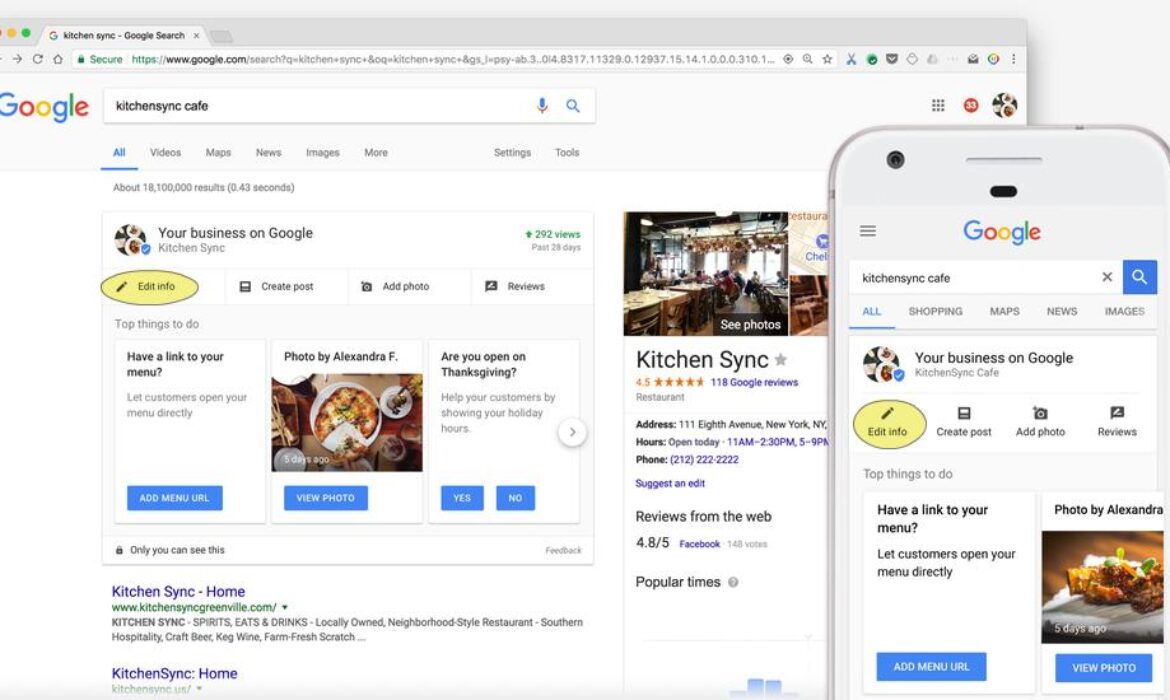You can now edit Google My Business Listings directly from the search results
For those of us that already have a verified business in Google My Business, we have some interesting news. You can now update your business info directly from the Google search engine result page. Please remember that need you to make sure you’re logged in to your Google My Business account.
Let’s try editing your Google My Business Page right from the search page
Let’s dive right in and see how it works. To get started, just type the name of your business in the Google search box and you will see a menu right above the search results. Again, you need to be logged in to your Google My Business account. After you click the edit info button, you will see all the fields you are able to edit become highlighted.
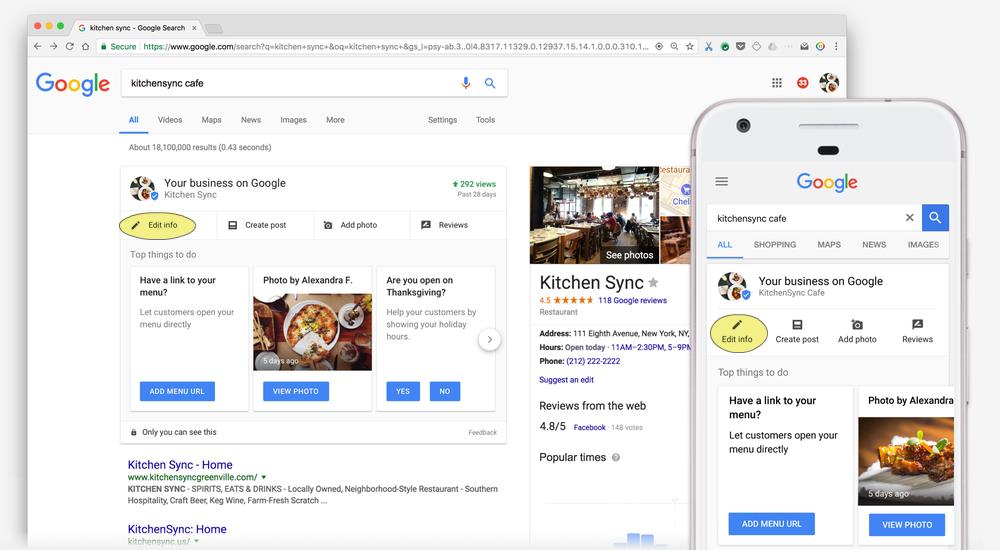
From here, you will be able to upload photos, see the number of views, check and respond to any customers reviews, and even access detailed info about your site metrics. The best part is, you can do it from any device, in your office on your desktop or right from your mobile device.
Google heavily relies on the business owners to provide accurate and updated information to their users. Google realized early on that if they want valuable content for free, they have to make the process simple and easy.
Now lets take a quick look at Why Google would do this?
For starters, who is best suited to provide the most accurate information about a business? The business owner, of course. Google decided to create a process to outsource the business info-update process, and now this process has just become a little more efficient. The good news is, this is a win not only Google but it is also a win for clients of local business because they get info directly from the business owners. The business owners win by getting to provide info directly to potential clients. Google wins by having the most up to date, timely and accurate local business info. A win-win-win situation for everyone!
If you are a business owner and you have not setup your Google My Business page, please contact us and we will send you a free guide.
SSL Certificates. What They Do AND Why You Need One
SSL Certificates, what are we even talking about? SSLs is the backbone of Internet security by protecting information as it travels the web. Often website owners balk at purchasing SSLs if their webpage isn’t set up for online shopping/money exchange. That is a mistake. SSL’s provide critical items like privacy, data integrity, and protection for your website and visitors to your page. SSLs digitally bind cryptographic keys to a website’s details. When Marlin installs an SSL on your server, it activates the padlock you see in your address bar and “https”. This creates secure connections between server and browser, protecting everyone.
Why do you need an SSL, especially if you are not running an e-commerce site? Data security between servers is increased. Your Google Ranking automatically increases when you provide your users with SSL protection. Trust is built and enhanced with your customer base when they know you’re doing your part to protect them. Should you have a form that visitors must fill out – whether it’s for an inquiry or something else to gathers information from the user, this type of data collection would prompt for the verification of your SSL. If you do not currently have an SSL on your website, then the user will be see the “unsecured content” message on their screen before they could proceed to the next page.
If a customer can trust that your site is safe and protected, then you will see your conversion rates increase!
Now you’re ready to jump into the SSL game, what next? SSL certificates must be issued from a trusted Certificate Authority. Marlin can help you through this entire process and can provide a list of trusted CA root certificates. Give Marlin a call and our experts will get you and your website ready to go!
Take a look at the different SSL certificates that we offer.
Have You Noticed A Change In Your Rankings? Google’s Shaking Things Up With Its New Local Search Filters
Google’s primary goal is to provide its users with the best possible search experience and they are leaving no stone unturned to ensure just that. In early 2017, Google introduced local search filters that allow users to sort results based on price, ratings and hours of operation. Taking it one step further, they are now automatically applying those filters and it benefits the user for obvious reasons. They get the best possible search as well as most relevant results on the fly without applying any filters.
It has turned out to be a big blow to some business owners who have failed or have not focused on maintaining a good online reputation. A businesses Local SEO strategy has to be adjusted to take this in to account. When Google automatically filters local businesses for those with 4-star ratings and higher, it places a lot of businesses at risk of losing online visibility. It’s quite common for users to search using terms like “Best Plumber”, “Best Thai Restaurant” and “Best Roofing Contractor” when they are looking for a local business. For those businesses that do not have more than a 4 star rating, they will find it extremely difficult to keep a measurable presence on local search.
In chaos we can sometime find opportunity and the golden opportunity in this case is for the less popular businesses. By inviting reviews & keeping their information consistent and updated, one can share the spot light with those who are already at the top.
The New Filters
The best of everything: Users can now filter the results automatically, by just adding “best” to the keyword. If you search “best plumber”, Google will show only 4-Star+ rated plumbers. This filter will drastically influence the way businesses are ranked. Check out how the following results differ.
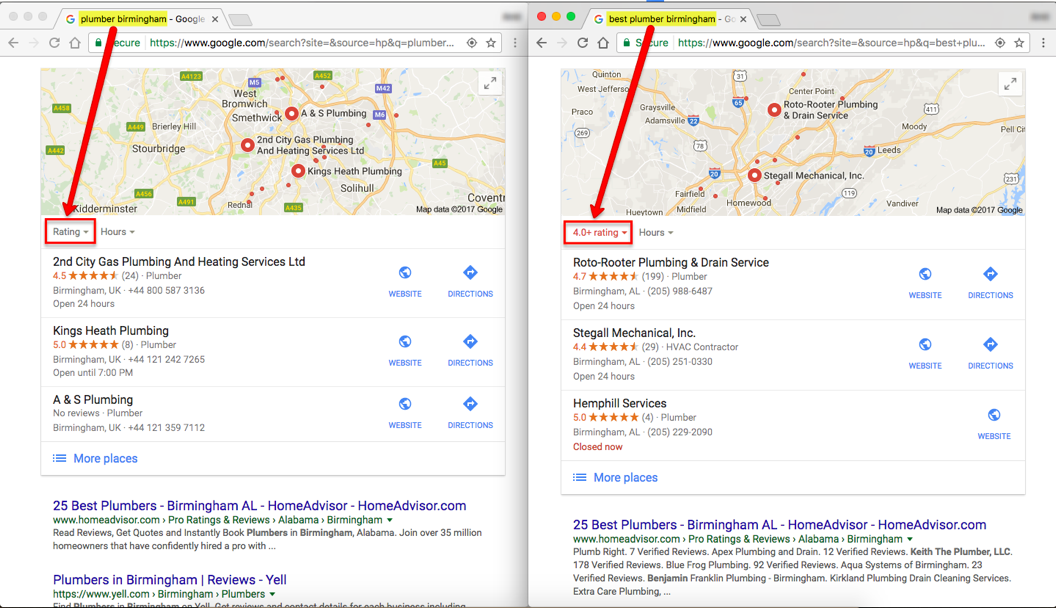
Open now: For example a closed Truck Repair store is of no use to a user who wants to get his truck repaired ASAP. So when a user types “truck repair store open now”, Google will show only those businesses that are open. Check out below.
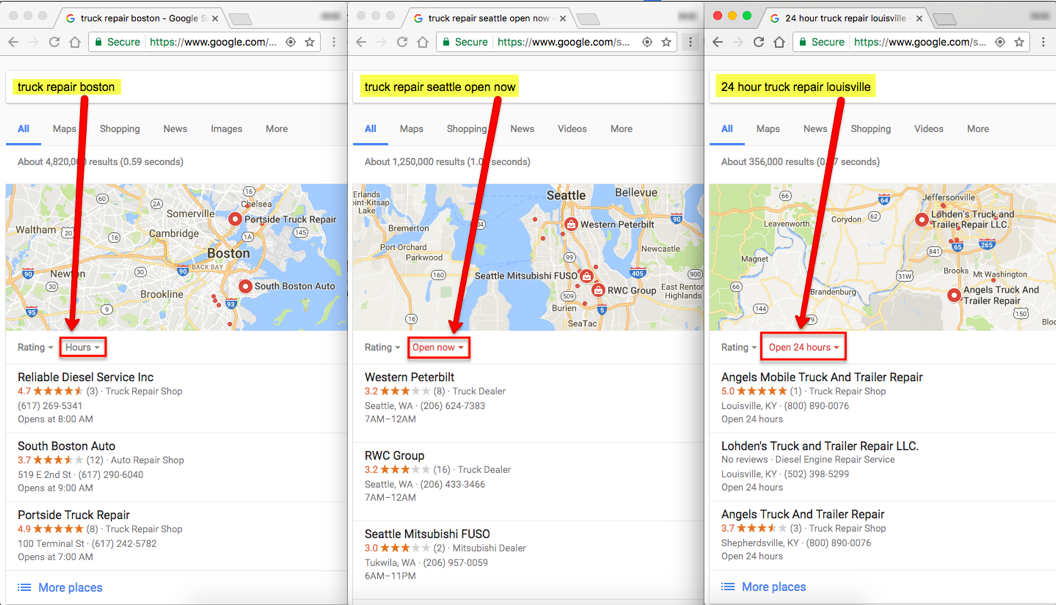
Enjoy Fine dining: Want to go to an upscale restaurant for your first date? Just type “fancy restaurant” & Google will show you the most expensive restaurants nearby. Or if you just want to fill your tummy without burning a hole in your pocket, type “cheap restaurants” or “budget restaurants” and you will get the list.
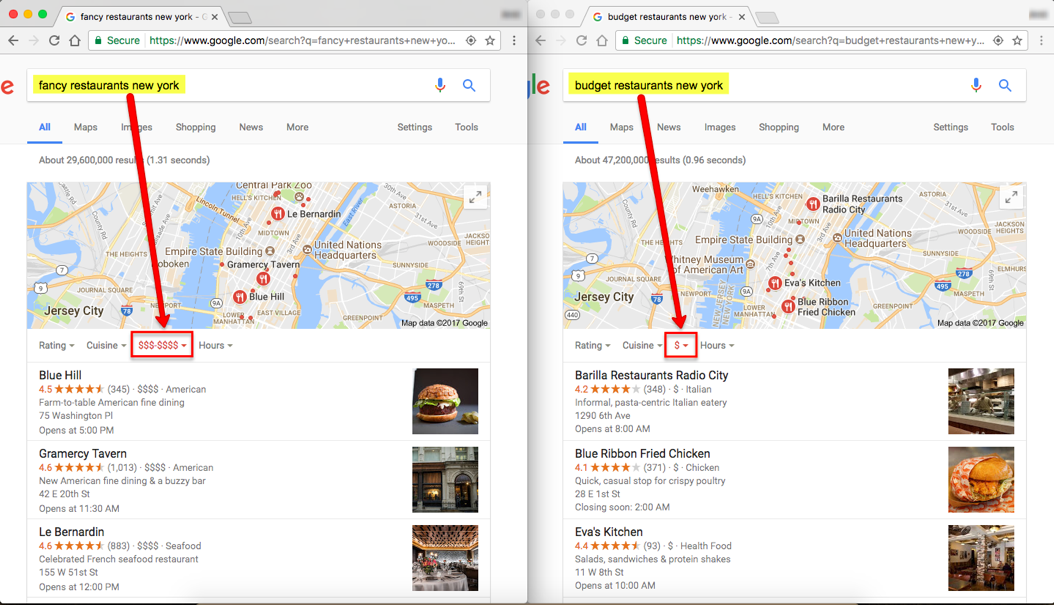
I am sure you see the bigger picture here, Google is and has been heading towards providing a more advanced search experience where users get results based on their actual intent. Local searches have grown to 46% of all searches on Google and will continue to rise. So, Google is doing everything it can to enhance the local search experience for its users.
Marlin’s take on this
Businesses that fail to manage their reputation and update their listings with the most accurate, detailed and consistent information now run the risk of not ranking in searches when they would have in the past.
To help you get more reviews for your business our Local SEO Plans includes our review widget. It’s a small piece of code which is placed on your website and helps you get positive reviews on Google, Yelp and Facebook. In addition, it helps to filter out negative reviews too thus ensuring a positive experience for your website users. Would you like to learn more? Please connect with us.
Meet Fred! Wait who is Fred? What does he have to do with SEO?
In the second half of 2016 a lot of the SEO (Search Engine Optimization) industry knew there
was something big coming down the pipe.
As expected, here comes Google making a rather significant change to their search algorithm in
early March of 2017. Code-named “Fred”, the impact is now changing the way many in the
digital marketing community are approaching their search engine optimization practices as well
how they develop in general. Let’s take a minute and get to know “Fred” and all his current
likes and dislikes.
Fred’s Focus
We know that Google makes hundreds of updates every year to its core algorithm, but Fred
seems to have made an impact on an unexpected number of websites, which has left some in
the digital marketing world scratching their collective head. Most of the major updates are
significantly affecting traffic, focusing on either links or content. If there is an organic traffic
drop it usually means that the site is in violation of the Webmaster’s guidelines on quality.
While we are always excited about Google bringing critical new changes to the web, the
challenge in this instance is there is no way to know for sure what the exact focus of Fred may
have been. In collaborating with other SEO professionals, our results seem to primarily point to
content related sites. Combing through the negatively affected sites, they all seem to have two
things in common. The content appeared “shallow” and the site prioritized advertising over
user experience. This is all obviously speculation at this point, BUT one might argue curbing ad-
focused sites is a positive change for the community.
How much havoc did Fred wreak?
Some SEOs and webmasters have reported organic traffic reductions of 50 to 90 percent. I am
sure you imagine that sort of traffic drop would be considered serious by any measure. While
the fall out hit a narrow segment of websites, it was still significant in the search engine optimization industry.
This of course all begs the question now what? How do we proceed? If your website fell in the
category of sites effected there are a couple things you can do:
Step 1: Don’t panic.
Step 2: Evaluate
If the website in question was very dependent on ad revenue, chances are there were too many
ad units and pop ups on the site. In this case, scaling back the ad units and then evaluating
other revenue streams is the way to go. If shallow content was to blame then the key will be
identifying those pages and updating your content with relevant, attention grabbing copy.
While in theory this is all relatively straight forward, the tactical part of Fred is far more
complex. Making these changes on a strategic level will become ever more important as we
continue to move forward in the future. If you would like to learn more about our search engine optimization services we would be happy to speak to you.
Social Media Don’ts
Let’s discuss some of the things you want to avoid when building your social media video presence. First, don’t just shoot for the biggest target. Just because Facebook has almost 2 billion users doesn’t mean they want to see what you’re putting out there. You have to find the right audience. Depending on your business, LinkedIn may be your best option; if you’re selling jewelry, clothing, or similar products, Pinterest or Instagram may work best. There are enough platforms for every type of business to find their niche!
When you get started it’s important you don’t use the spaghetti approach. You can’t just throw everything at a wall and see what sticks. If you try that, you’re going to have significant trouble building your audience. You need to create consistent content to build a consistent audience that looks for your videos as you post them to social media. Obviously if something unexpected or exciting happens you don’t miss that opportunity but surprise or unusual posts should not replace your regular consistent content schedule.
Come see us at Marlin if you’re ready to get your social media video campaign started!
Making Videos on Social Media
Online video is becoming the medium of choice in the digital world. Did you know there are a BILLION YouTubers? Facebook and Snapchat are racking up as many as 8 BILLION video views per day between them. We’re talking in the billions, 3 commas for you “Silicon Valley” tv show fans.
The danger here is jumping in without taking a moment to understand the medium. Fun fact, predictions are that 74% of all web traffic will be video by the end of this year. Most significantly, businesses that have focused on video for their marketing efforts have seen an increase in conversion rates. This means that video is becoming the a more effective driver of sales than traditional options.
Some key characteristics of a social video are viewers will want to share it, it will encourage audience engagement, and it is optimized so it is easy to upload or share on social media platforms. Remember social videos are not trying to be viral videos. Your goal with a social video is to create interest in your product among your target audience.
We are just beginning our exploration of social videos. Check back next week for more about social video and how to apply it to your website plan!
Dense Content
Content Density
This the concept that deals with the idea of avoiding superficial posting. Content these days has become quite superficial and that does prospective customers no good. The goal with content should be to highlight your uniqueness, your differences, from your competition. The challenge comes with keeping it interesting. Getting truly lengthy and in-depth on your website can take you straight down the rabbit hole and you’ll lose your audience.
Creating your dense content is only half the battle.
The other part is identifying what works best with your audience. Is shorter content better? Or something more creative and in-depth? Based on that kind of feedback you can focus on keywords and be specific to your product or service and price. If you can get more creative you may prefer more shorter write ups to draw in your audience without overwhelming them. Finally, be sure to include local terms or locations of significance that will mean something to your clients. Phew! Lots to remember but the most important part is to stay connected to your clientele. Try to put yourself in their shoes as you work your write ups. Lucky for you, Marlin specializes in dense content and local clientele!
Rich Answers and Local Links
Rich answers had a great year in 2016. Because most people search online using questions instead of keywords, Google has begun returning information that doesn’t require you to click on search results to get details. If you Google a famous person’s name, that person’s details appear as a Knowledge Panel on your results page. If you search using “how to” or “where is” you’ll get a Featured Snippet at the top of your results or map locations and Google business listings. Why does this matter? If you keep your Google My Business listings updated your business will keep you at the forefront of Google search land.
An extension of rich answers and their impact on your business visibility, local links are a critical component of your success. You’ve probably noticed there are local listing sites in your area where you can publish your business listing. Be sure to take advantage of all these types of sites, every little bit of exposure will impact your business. When you publish on local listings like this, you build valuable local links that will help build your regular SEO. Additionally, you can have other business sites link to yours and vice versa. While you’re at it, gain visibility through local news sites and blogs and work with them to write about your businesses and your products and services.
The great thing about rich answers and local links is how quickly and easily you can significantly impact your local footprint with a little work keeping your Google My Business listings updated and staying current on your local directories. Good luck! Let’s do this!
NAP – Name, Address, and Phone Number. Local Strategies to Boost Your Business
As obvious as this seems, you’d be amazed how difficult it can be to find this information on a business homepage. Aside from the basic importance of letting potential customers know how to contact you, NAP data is actually used by search engines when local searches are performed. If your NAP is prominently part of your website, each time it is cited in directories or web searches counts toward your local SEO. To ensure absolute maximization, you’ll want to add all of your business’ details to your Google My Business listing.
Part of the NAP puzzle is accessibility. You need to keep your NAP data consistent, easy, and straightforward to make it easy for Google and other search engines to snap it up. Another little tip, Don’t put your address and contact info in an image. Business owners tend toward flashy, eye catching images and graphics but typing actual text is better for SEO purposes.
Interestingly enough, in the last two years people have been using questions more and more instead of keyword searches. Google has begun returning search results that don’t require users to click on search results to get details. You can even test this thesis. Search a famous person on Google, their details will show as a “knowledge panel.” If you type in a question like “how to” or “where is” and you’ll get a Featured Snippet at the top of your results page or a map with locations and Google My Business listings.
Who cares, right? But imagine what that sort of return will do for your business when a potential new customer is on the hunt for a convenient nearby option and you pop up with all your data AND a mapped location. You’ve taken the variables out of the game and guided someone directly to you. Everybody wins!
REVIEWS – Local Strategies To Boost Your Business
Over the next few weeks, the Marlin Blog is going to cover some SEO strategies designed specifically to give small businesses a boost in their local area. Hopefully one, or all, of these can do something for you. I’ll focus on a few specific sites as we discuss, but keep in mind there are dozens of sources out there!
We’re going to lead off with reviews. I’ve touched on this in the past, but reviews are a fantastic way to influence potential customers. User reviews impact how local search engines rank a website. Because of this, a business can increase visibility almost immediately by simply generating customer reviews of their products or website. In addition to the positive boost on search engines, a customer review is one of the best ways to advertise to potential new customers.
In this online world in which we live, personal, genuine recommendations are like gold. Think about it. When I travel to a new city, my husband and I jump on Trip Advisor or Yelp to check restaurant recommendations or local activities. We make our decision based on the sites’ ratings. Those ratings are generated through the recommendations of people just like us. The challenge in this review driven world is to get “real” reviews. As the fun of Amazon reviews has proven, customers tend to be more motivated to write reviews when the service or product was so amazing it was epic or so bad it was epic. To win the review game, we have to break the code with customers writing reviews regularly.
There are a few strategies to improve the review game. To start with, reach out to your regulars and ask them to share their experiences online. You can provide them with links to help make the process as smooth as possible. Make sure you have a business listing on Google! If you don’t have one, create one and use that as your link. Another one is to offer discounts or “rewards” to people who check in and review your business. Encourage reviews by making sure your website says “Check us out on Yelp” or “Check us out on Trip Advisor”.
The easier and more intuitive you make the review process for your customers, the more likely they will be to give you a review. Marlin is here to help you open up that recommendation window! Give us a call and let’s get started!

